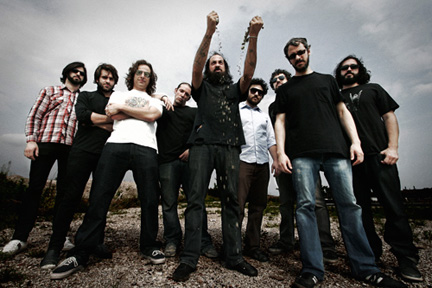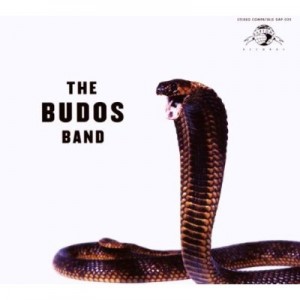First off, can we get an Amen for Daptone Records?
You know a label has arrived when you go from being pleasantly surprised at the consistent quality of each new release to just expecting excellence. We are now officially past that point: this Brooklyn collective has amassed a considerable stable of talent that has been making some of the best music around for several years. Thanks in no small part to the growing and richly-deserved success of label sweetheart Sharon Jones, Daptone Records went from being the little label that could to the major label that did.
Which brings us to the Budos Band. If Sharon Jones can be considered the heart of Daptone, the Budos Band is, well, the balls. Their trajectory mirrors that of their label: the self-titled debut was a welcome, somewhat out-of-the-blue exercise in nostalgia for funkier days. Their second picked up where they left off, leaving little question that they were for real. Their new release, The Budos Band III is a reiteration of an old-is-new mission statement, but it signals a simple fact: The Budos is upon us.
If you find yourself asking who are they and what do they sound like, there is a short answer and a long answer. The short answer: the Budos Band brings the funk so ferociously you find yourself wanting to throw a party so you can use them as a soundtrack. The long answer: If you’re at all familiar with ‘70s funk (in general), the J.B.’s (in particular), Ethiopian jazz, Afrobeat, Antibalas, and the organ-based assault of Medeski, Martin, and Wood, you’ve heard them before. But they are more. The Budos Band is like a reincarnation of a sound that has not yet been heard. There is nothing reductive or formulaic going on; rather, they are following (and, frankly, perfecting) a loud and proud lineage.
The African grooves of Fela Kuti and the stop, drop, and roll rhythms of James Brown’s funk apotheosis were often opposite sides of the same coin. The Budos Band has slyly taken some of the best elements of both, flavored the broth with some of the aforementioned influences, and cultivated a sound that is familiar but never too friendly.
As if to ensure that their musical message (which you are likely to love at first listen) is not conveyed lightly, the band is in the habit of choosing assertive album art. Their excellent first release features a volcano spewing lava (like good, filthy funk) across the land. Their just-as-good follow-up depicts a scorpion (like a killer groove) ready to strike. Their new one sports a cobra, mouth open and ready to squirt some venom (like the truth) into your eyes, or ears. And the truth is, this is not only the Budos Band’s best work, this one will end up on some end-of-year lists. Simply put, the time could hardly be more right for this band to get some serious attention, and lap up the inevitable accolades.
If the words “fun” and “funky” are not enough to convince you, perhaps a few more will suffice. When there are ten musicians with this much talent, it requires restraint and wisdom to take a less-is-more approach. Make no mistake; there is nothing “less” about any of these compositions. Because of the tight arrangements, every second of every song counts—all the sounds matter, and a serious vibe emerges. This is party music for your mind. The solos are clean, sharp, and brief—almost tantalizingly so. But three albums in, it is increasingly obvious that this is the band’s calling card: rather than expansive (see: ponderous and rambling) jams full of sounds and lacking fury, the Budos Band is able to craft compelling, irresistible blasts of bliss.
Needless to say, rocking the house in under four minutes per song requires talent, but it is ultimately a reflection of serious discipline and smarts. These guys don’t make congas an obligatory, if minor part of the equation; the double-conga (and/or bongo) attack provides a solid foundation from which the funk unfurls. The bass and organ establish a fat framework for the brass, and the two trumpet, baritone sax, and flute front line does not disappoint. Everyone gets a chance to shine, but special props must be set aside for Jared Tankel, who handles saxophone duties and shares songwriting credits on most of the tunes. Plus, it’s not often (or often enough) that one can enjoy a larger band where the baritone sax is not utilized solely as sonic window dressing. Here, the gigantic, glorious horn bum rushes the show like a warthog in a rented tux. It’s hard to pick highlights, but it’s always a good sign when you listen to an album for the first time and stop to replay the opening track three times. It’s that good. “Budos Dirge” will make you recall—and want to pull out—your Mulatu Astatke discs (if you don’t have any, put that on your list). “Raja Haje” sounds like a classic Fela Kuti groove that has been judiciously edited. What could easily be an ass-shaking 20-minute workout is, instead, a bite-sized bolt of goodness you can play over and over. “Reppirt Yad” is a droll, skanky shakedown of the Fab Four’s “Day Tripper”, and an ideal album closer. Both “Black Venom” and (the geniously titled) “Unbroken, Unshaven” boast the band’s chops and cause one to hope they will be touring a town near oneself, soon. Finally, “Nature’s Wrath” is an instant masterpiece: this dirge-like number sways and soars, sounding like a somber celebration that makes you want to dance and sob at the same time.
If you’re not convinced yet, listen to some sound samples online (go to their official site, or the Daptone Records site, or if all else fails, you may have heard of a thing called YouTube). If, after checking it out, you remain unconvinced, check your head. And check for a pulse.


